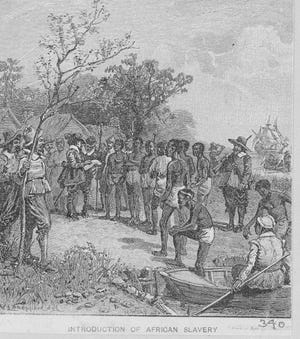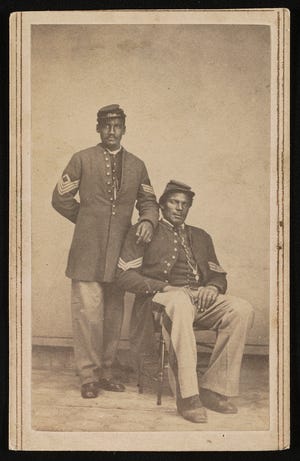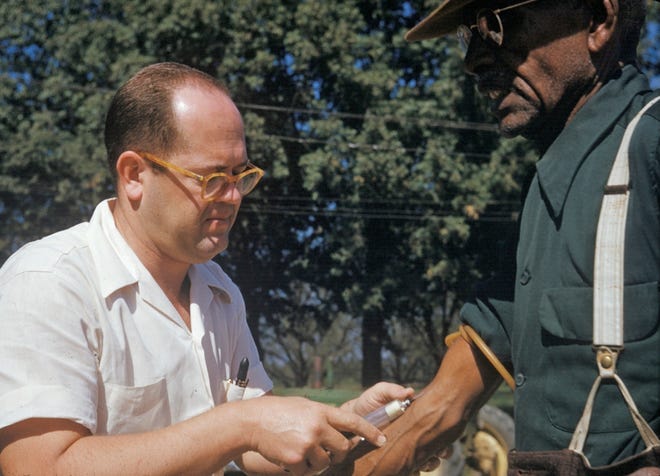Health and race disparities have deep roots: A brief timeline

[ad_1]
Tammy Joyner and Jasmin S. Lee
Here are a few historical examples of how race, and racism, has greatly impacted the health outcomes of African Americans.
1619 to 1730: Africans were enslaved and transported to the American colonies to be treated as property, receiving little to no medical treatment.

1742: Onesimus, a Boston enslaved person, told his owner about a procedure where he became immune to smallpox by exposing himself to the bacteria of someone with smallpox through an open wound, an early inoculation. His owner, Cotton Mather, experimented with this treatment and only six people out of 242 died. Although Onesimus contributed to this knowledge, he received terrible treatment as a slave and was punished severely for not converting to Christianity.
1830s: Samuel George Morton wrote “Crania Americana: Or a Comparative View of the Skulls of Various Aboriginal Nations of North and South America,” in which he claimed that black people had smaller skulls than white people and thus smaller brains. Experts contend this work provided the foundation of scientific racism.
Mid-1800s:Surgeon James Marion Sims became known as the “father of modern gynecology” for developing surgical techniques that help women through a difficult childbirth. Sims created his techniques by operating on enslaved black women without using anesthesia. He experimented on enslaved black women in a makeshift hospital behind his house in Alabama. He founded the Women’s Hospital and practiced medicine abroad in Europe.
1861-1865: During the Civil War, there were separate wards for wounded black soldiers in the Union Army; they were poorly staffed. Black soldiers would die from wounds that white soldiers would recover from due to a lack of supplies and treatment. Blacks continued to be used in medical experiments without consent, dead or alive.

1863:The Emancipation Proclamation declared that all slaves living in southern states were freed.
1899:In the book “The Philadelphia Negro,” sociologist and activist W.E.B. Du Bois argued that the differences in health outcomes for blacks and whites had more do with living conditions, than genetics.
More:COVID-19 and Detroit: How racial inequity turned deadly in a city amid a comeback
1913: Sterilization laws were centered towards people with mental illnesses in its beginning stages, but expanded to a list of different medical conditions and extreme circumstances that gave doctors leeway in choosing who to sterilize. These laws drastically affected African Americans. African Americans are four times more likely to be sterilized than their white counterparts.
1932: The U.S. Public Health Service started a 40-year experiment looking at the “natural history” of untreated syphilis. Some 600 poor, black sharecroppers enrolled in The Tuskegee Study of Untreated Syphilis in the Negro Male. Participants include 399 men with latent syphilis and 201 who don’t have the disease. Participants were told they were getting free medical care from the federal government. They were unaware that they had syphilis, which ensured that government doctors could study the disease and the effects it had on the participants. Even when a treatment for syphilis became available the men were not treated.

April 10, 1945:Ebb Cade, an African American male, was the first test subject in the Human Radiation experiment (ie. Manhattan Project) in Oak Ridge, Tennessee. He got in a car accident on March 24, 1945, and fractured bones in his arms and legs. While waiting for treatment on April 10, he received injections of 5 mg of plutonium without his consent. Cade did not receive any treatment for his bone fractures until April 15. Fifteen of his teeth were extracted to see the results of the radiation. Cade died 8 years later from heart failure.
Oct. 4, 1951: Henrietta Lacks, a 31-year-old African American mother of five from Virginia, died of cervical cancer. Medical researchers use her cancer cells, known as the HeLa cell line. Lacks’ cells are one of the most vital cell lines in medical research. It has been used to study the effects of toxins, drugs, hormones, and viruses on the growth of cancer cells without experimenting on humans. The HeLa cells were used to develop the polio vaccine and in cancer and AIDS research. Doctors never got Lacks or her family’s permission to culture her cells.
1960s: The Civil Rights movement helped pioneer legislation such as the Civil Rights Act of 1964, hospital desegregation, the Voting Rights Bill, and passages of Medicare and Medicaid. The African American community saw an increase in overall health for the next decade due to these changes.

May 16, 1997: After a $10 million out-of-court settlement was reached in 1974 for the participants of the Tuskegee Syphilis experiment, President Bill Clinton formally apologizes to victims on behalf of the United States government. The victims are all African American and include numerous men who died of syphilis, 40 wives who contracted the disease and 19 children born with congenital syphilis.
1997:The W.K. Kellogg Foundation gives funding to the University of Michigan Historical Center for Health Sciences to research the healthcare experiences of African Americans who lived in southeastern Michigan during the 1940s through the 1960s. They collected 42 oral accounts of these experiences and held projects presenting this research until 2000.
More:Family ravaged by coronavirus begged for tests, hospital care, but was repeatedly denied
2005:African Americans are 10 times more likely than whites and nearly three times more likely than Latinos to have AIDS. This comes after surveys show from the New York Times that ten percent of African Americans believe AIDS was created specifically to target the African Americans.
2007: “Medical Apartheid: The Dark History of Medical Experimentation on Black Americans from Colonial Times to the Present,” a book by Harriet Washington is published. In addition to highlighting medical experiments, it also explains why many African Americans have deep mistrust in medical professionals.
July 30, 2008:The American Medical Association apologizes to the National Medical Association, a society of African American physicians. For more than a century, the AMA reinforced or passively accepted racial inequalities and excluded black doctors from AMA as well as state and local medical societies.
2010:“The Immortal Life of Henrietta Lacks” a book by Rebecca Skloot is published. (A film by the same name was produced by Oprah Winfrey and released in 2017.) Skloot created the Henrietta Lack Foundation in 2010 to help families that underwent medical experiments without consent.
April 25, 2014: As a cost-saving measure, Flint, Mich., switches its water supply to the Flint River introducing lead-poisoned water into homes and creating a massive public-health crisis. Lead is toxic to human. More than half of Flint residents are black.
January 2, 2015:Flint residents were notified by city officials that their water supply violated the Safe Drinking Water Act. The water was verified to have high levels of TTHM, total trihalomethanes, which can cause multiple medical complications if consumed in large amounts.
April 4, 2016: Half of 222 white medical students and residents surveyed at the University of Virginia believe blacks and whites are biologically different, according to a paper published in the Proceedings of the National Academy of Sciences. They also believe blacks felt less pain than whites and thus were more likely to suggest inappropriate medical treatment for black patients. This is believed to be the first study linking racial bias to biology, racial perception of pain, and the accuracy of medical advice.
April 2018: After much protest, the New York Public Design Commission unanimously voted to remove a statue of James Marion Sims from Central Park and placed it in Greenwood Cemetery where he’s buried. Other memorials of Sims still remain in South Carolina and Alabama where he was named to the Alabama Hall of Fame.
Jan. 16, 2020: The National Center for Health Statistics releases 2018 data on pregnancy-related deaths showing black women die 2½ times more often than white women. Hispanic women have the lowest rate of maternal mortality. Researchers do not have a clear reason for the high mortality rate for black women, but suspect institutional racism and susceptibility to certain conditions such as obesity and hypertension as well as lack of access to quality prenatal care.
Additional research:
https://www.hopkinsmedicine.org/henriettalacks/
https://www.bridgemi.com/truth-squad-companion/flint-crisis-timeline-part-2
http://henriettalacksfoundation.org/
https://www.ncbi.nlm.nih.gov/pmc/articles/PMC2593958/pdf/jnma00341-0013.pdf
[ad_2]
Source link
